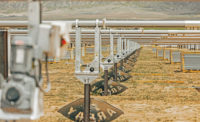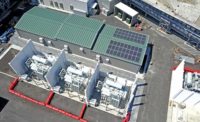Clover Creek Substation
Mona, Utah
BEST PROJECT
Submitted By: Hunt Electric Inc.
Owner: AES Corp.
Lead Design Firm: Intermountain Consumer Professional Engineers Inc.
General Contractor: Hunt Electric Inc.
Civil Subcontractor: Titan Constructors
Instrument Control Builders: Instrument Control Co.
This substation supports a 560-acre, $80-million solar farm built west of Mona Reservoir in rural Juab County, Utah. Generating 80 MW of energy, the facility replaces coal-fired power with low-cost solar power.
The team says the design-build delivery method was crucial to the project’s success. It ensured that the most critical systems for completing the project on time were designed first. It also allowed for the modification of typical substation design to meet the construction schedule and its critical milestones. This delivery method enabled the procurement of materials before the design was 100% complete, avoiding potential schedule interruptions from material delivery delays.
The strict schedule required buy-in from the entire team, including trade partners and suppliers. A critical component was the 100-MW transformer that converted the power to a higher voltage for efficient delivery to end users. Installation of the 260,000-lb transformer required careful planning and coordination to ensure the site was ready before the transformer’s fixed delivery date. The substation’s connection to the national power grid was another critical milestone that had to be completed within a narrow outage window. Missing this window could have delayed the substation’s ability to transmit power from six months to one year.

Photo courtesy Hunt Electric Inc.
Critical materials were ordered early to create a buffer in the schedule. The team also established strict safety standards, which were critical to ensuring safe operations on a site with 345,000 volts of power. The team developed a site-specific safety program for those substation standards and for working in the vicinity of an energized public utility. Safety standard policies were individually signed by craft personnel, trade partners, delivery drivers, owners and representatives of any companies that visited the site.
More than 60% of the work took place during the winter months, and accelerating admixtures were added to concrete that was heated when placed to ensure proper setting. Additional quality assurance methods included custom welding on the substation’s aluminum bus work. The fabrication team was located on site to ensure that parts were available to keep the project running on schedule.




